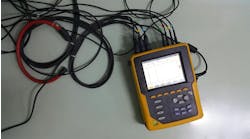When troubleshooting a power quality (PQ) issue, sometimes the equipment that provides the most grief can help find the problem. For example, the equipment itself is operating properly, but the connection upstream may have been partially severed (causing a high impedance), or adjacent equipment is showing signs of failure (creating distortions on the line). Today’s electrical equipment has built-in protection and monitoring components that can display fault codes, thus identifying why it has shutdown. These fault codes along with the timestamps are two pieces of information that are surprisingly overlooked by some users.
It is important to understand these fault codes and what is being reported by the device. The manufacturer typically provides a data sheet that describes the fault codes and may suggest mitigations for them in their provided literature. Typical fault codes include overvoltages, undervoltages, phase loss, and phase imbalance. However, the list can get pretty extensive, depending on the features of the equipment.
The thresholds of when the fault codes are reported and when the equipment shuts down can be adjusted by the user. For example, motor protection devices can have voltage imbalance settings that are adjustable from 1% to 8% or more, depending on the equipment arrangement. However, the user needs to be cautious when adjusting these settings. Not consulting the manufacturer may impact or void the equipment’s warranty, especially if not set properly. Some manufacturers require the user to derate the motor when operating in an unbalance state. There are also settings not available to the user and only accessible with aid of the manufacturer. These values are for the inner workings of the equipment and can have adverse effects on the equipment when not adjusted properly, which typically is why the manufacturer doesn’t make them available.
Timestamps that accompany fault codes are another piece of valuable information; especially when a piece of equipment is effecting the lines in a way where it triggers a fault code on a separate device. Having the time stamp of the event and correlating it with the operations of another piece of equipment will significantly reduce the troubleshooting time and help narrow down the issue.
There have been times when the equipment reports an incorrect diagnosis. For instance, its possible a solar inverter can report a frequency issue when in actuality it was high harmonics being injected on the distribution circuit by an adjacent customer. Thus, relying solely on fault codes can lead the investigation in the wrong direction. It’s best to independently verify the fault code with a separate meter to validate the readings.



